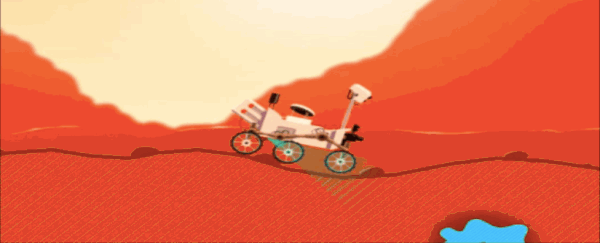To celebrate Curiosity's fourth Martian birthday, NASA has just released a free game called Mars Rover in which players can drive around the Martian surface just like their favourite rover.
While the game is surprisingly addictive, it also shows players how the second Mars rover – scheduled for launch in 2020 – will scan under the Martian surface in search of water.
"We're excited about a new way for people on the go to engage with Curiosity's current adventures on Mars and future exploration by NASA's Mars 2020 rover too," public engagement manager Michelle Viotti, from NASA's Jet Propulsion Laboratory, said in a statement.
"Using social networks, the user can share the fun with friends. The interest that is shared through gameplay also helps us open a door to deeper literacy in science, technology, engineering and mathematics."
To create the game, NASA teamed up with developer GAMEE, which created a free version for Desktop, Android, and iOS.
In it, you get to play as Curiosity as you explore the Martian landscape, collecting samples and traversing steep, tricky terrain, all in the name of science. But, be warned, the 2D view looks deceptively simple - it's not actually that easy.
If you get stuck or find the game harder than you expected, remember that right now, the real Curiosity is about drill into a rock called 'Marimba' to collect a powder sample - a task that seems simple at first but is anything but when you realise it's taken Curiosity multiple months to reach the site, moving at a speed of only about 5 centimetres (2 inches) per second. Any error could become catastrophic.
In fact, it takes so long for the rover to do anything that - in the four years it's been on Mars - it's only travelled roughly 13.5 kilometres (8.4 miles) - though in that time it's beamed back over 128,000 images and fired its laser over 362,000 times.
One of the most important discoveries made by Curiosity happened in its very first year. After landing on the Red Planet on 6 August 2012, it made its way to a site called Yellowknife Bay, where it found evidence that suggests Mars has all of the ingredients needed for microbial life, despite no evidence so far that it ever existed there.
The new game isn't the only time NASA researchers decided to have a little fun for Curiosity's birthday. Back in 2013, for the rover's first birthday on the planet, researchers managed to program its instruments to make it hum Happy Birthday to itself, making Curiosity the first thing ever - that we know about, anyway - to celebrate a birthday on Mars.
You can download GAMEE from the App Store, Google Play, or play it on your desktop, and check out the video below to hear Curiosity hum Happy Birthday:
H/T: Gizmodo
